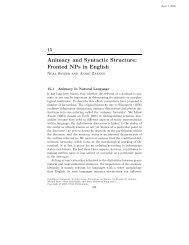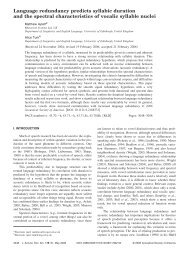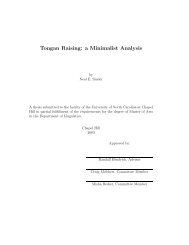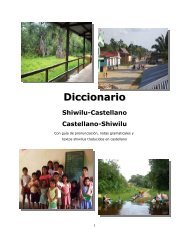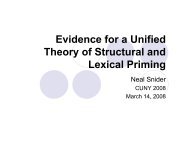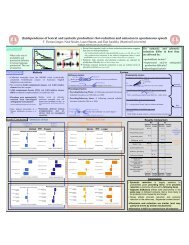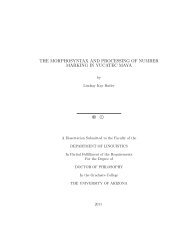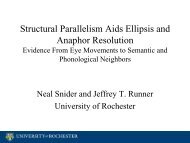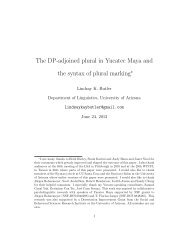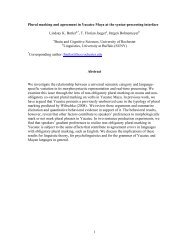Weak definite noun phrases: rich, but not strong, special, but not ...
Weak definite noun phrases: rich, but not strong, special, but not ...
Weak definite noun phrases: rich, but not strong, special, but not ...
You also want an ePaper? Increase the reach of your titles
YUMPU automatically turns print PDFs into web optimized ePapers that Google loves.
F-value pNoun Type 0.8478 0.357Article 1.0271 0.311Number of Pictures 47.1137 1.42e -11 ***Noun:Article 3.0096 0.083 .Noun:Pictures 13.92 0.0002 ***Article:Pictures 1.708 0.1916Noun:Article:Pictures 2.688 0.1014Table 1: 3-way ANOVA for Experiment 2rating. <<strong>strong</strong>>Weak</<strong>strong</strong>> in<<strong>strong</strong>>definite</<strong>strong</strong>>s (rode a bus) were somewhat worse, and close behind were regular in<<strong>strong</strong>>definite</<strong>strong</strong>>s(rode a bike). The regular <<strong>strong</strong>>definite</<strong>strong</strong>>s (rode the bike) were much less acceptable. Mean ratings fortwo-referent scenes are shown in Table 2.Definite In<<strong>strong</strong>>definite</<strong>strong</strong>>Regular 3.676 4.242<<strong>strong</strong>>Weak</<strong>strong</strong>> 4.828 4.717Table 2: Mean Ratings for Two-Referent ScenesAn Analysis of Variance for the two-referent conditions showed a significant interaction (seeTable 3): the weak/regular <<strong>strong</strong>>noun</<strong>strong</strong>>-type distinction matters more when the NP is <<strong>strong</strong>>definite</<strong>strong</strong>> thanin<<strong>strong</strong>>definite</<strong>strong</strong>>. In other words, <<strong>strong</strong>>noun</<strong>strong</strong>>s allowing a weak <<strong>strong</strong>>definite</<strong>strong</strong>> reading are generally more acceptablewith two-referent scenes than <<strong>strong</strong>>noun</<strong>strong</strong>>s that do <<strong>strong</strong>>not</<strong>strong</strong>> have a weak interpretation, <<strong>strong</strong>>but</<strong>strong</strong>> this differenceis greater in <<strong>strong</strong>>definite</<strong>strong</strong>> than in<<strong>strong</strong>>definite</<strong>strong</strong>> NPs. Regular <<strong>strong</strong>>definite</<strong>strong</strong>>s are less acceptable with these scenesthan regular in<<strong>strong</strong>>definite</<strong>strong</strong>>s are; however, the reverse pattern is true for weak <<strong>strong</strong>>noun</<strong>strong</strong>>s, where <<strong>strong</strong>>definite</<strong>strong</strong>>sare actually better (albeit <<strong>strong</strong>>not</<strong>strong</strong>> significantly) than in<<strong>strong</strong>>definite</<strong>strong</strong>>s for describing two-referent scenes.F-value pNoun Type 6.4755 0.01135 *Article 0.056 0.8127Noun:Article 4.249 0.0399 *Table 3: 2-way ANOVA for 2-referent conditionsCuriously, weak in<<strong>strong</strong>>definite</<strong>strong</strong>>s are more acceptable with two referents than regular in<<strong>strong</strong>>definite</<strong>strong</strong>>s are.We speculate that this marginal difference could be due to the lexical aspect of weak <<strong>strong</strong>>definite</<strong>strong</strong>>s: evenwhen paired with an in<<strong>strong</strong>>definite</<strong>strong</strong>> article, these <<strong>strong</strong>>noun</<strong>strong</strong>>s, in the right context, might be preferentiallyinterpreted as evoking an event rather than an individual. That is, in the sentence “Jerome andSandy rode a bus”, a bus may evoke the activity of bus-riding, rather than an individual discourseentity bus. Additionally, a planned t-test between the weak <<strong>strong</strong>>definite</<strong>strong</strong>>s and the regular in<<strong>strong</strong>>definite</<strong>strong</strong>>sshows these conditions to be significantly different (t=-2.249, p-value=0.025), giving support tothe claim that weak <<strong>strong</strong>>definite</<strong>strong</strong>>s are <<strong>strong</strong>>not</<strong>strong</strong>> regular in<<strong>strong</strong>>definite</<strong>strong</strong>>s in disguise and might <<strong>strong</strong>>not</<strong>strong</strong>> prompt theestablishment of discourse entities to the same extent.7



